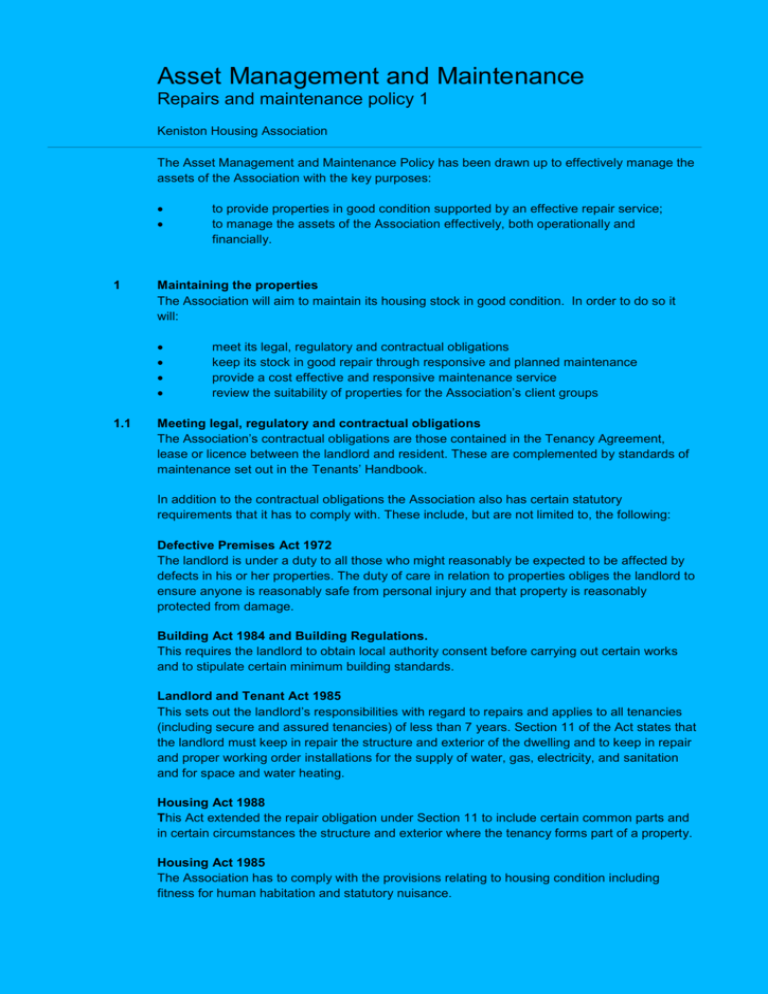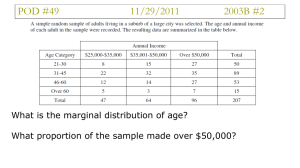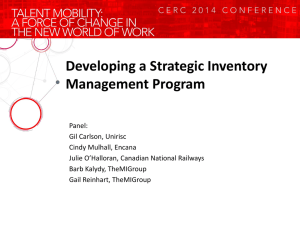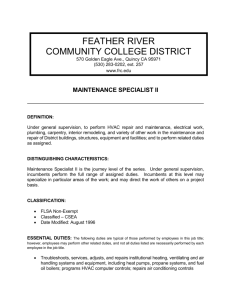Maintenance and asset management
advertisement

Asset Management and Maintenance Repairs and maintenance policy 1 Keniston Housing Association The Asset Management and Maintenance Policy has been drawn up to effectively manage the assets of the Association with the key purposes: 1 Maintaining the properties The Association will aim to maintain its housing stock in good condition. In order to do so it will: 1.1 to provide properties in good condition supported by an effective repair service; to manage the assets of the Association effectively, both operationally and financially. meet its legal, regulatory and contractual obligations keep its stock in good repair through responsive and planned maintenance provide a cost effective and responsive maintenance service review the suitability of properties for the Association’s client groups Meeting legal, regulatory and contractual obligations The Association’s contractual obligations are those contained in the Tenancy Agreement, lease or licence between the landlord and resident. These are complemented by standards of maintenance set out in the Tenants’ Handbook. In addition to the contractual obligations the Association also has certain statutory requirements that it has to comply with. These include, but are not limited to, the following: Defective Premises Act 1972 The landlord is under a duty to all those who might reasonably be expected to be affected by defects in his or her properties. The duty of care in relation to properties obliges the landlord to ensure anyone is reasonably safe from personal injury and that property is reasonably protected from damage. Building Act 1984 and Building Regulations. This requires the landlord to obtain local authority consent before carrying out certain works and to stipulate certain minimum building standards. Landlord and Tenant Act 1985 This sets out the landlord’s responsibilities with regard to repairs and applies to all tenancies (including secure and assured tenancies) of less than 7 years. Section 11 of the Act states that the landlord must keep in repair the structure and exterior of the dwelling and to keep in repair and proper working order installations for the supply of water, gas, electricity, and sanitation and for space and water heating. Housing Act 1988 This Act extended the repair obligation under Section 11 to include certain common parts and in certain circumstances the structure and exterior where the tenancy forms part of a property. Housing Act 1985 The Association has to comply with the provisions relating to housing condition including fitness for human habitation and statutory nuisance. page 2 –Asset Management and Maintenance, repairs and maintenance policy 1 Sections 96 – 99 of the Housing Act 1985. This gives secure tenants, in certain circumstances, the right to repair (Section 96), to make improvements with consent (Section 97 – 98) and the right to claim compensation with regard to improvement (Section 99A). Section 104 of the Housing Act 1985 A landlord has to publish certain information regarding the contractual obligations within the tenancy agreements. This applies to secure tenancy agreements only. Environmental Protection Act 1990 This provides for the Local Authority to serve notices relating to a statutory nuisance and require works to be done. Failure can lead to prosecution. Housing Act 1996 Tenants have a right to report matters of complaint, including in relation to repairs, to the Housing Ombudsman Service. The regulator for social housing has power to enter a property to carry out a survey, if the Landlord is failing to maintain the premises. The Act also restricts the right of forfeiture for non-payment of service charge. Health and Safety at Work Act 1974 The Association should work to ensure its staff and contractors fulfil their obligations under the Health and Safety at Work Act and associated regulations of 1999 and amendments of 2002. Housing Act 2004 The Housing Health and Safety Rating System was introduced by this legislation to provide means of a risk assessment for properties. Construction Design & Management Regulations 2007 The Association shall work in co-ordination with its contractors to ensure compliance with CDM regulations and promote site safety. 1.2 Standards for Keniston’s properties General The Association will aim to keep all its stock in good and habitable condition, which meets the needs of and offers choice to residents and has the objective of completing repairs and improvements right first time. Planned maintenance and servicing will take place at the required intervals. Maintaining properties free of dampness and water penetration is a priority. Day to day maintenance Repairs carried out in response to day to day defects will be carried out on a like for like replacement to maintain the standard of the buildings. Void property A void standard has been adopted which ensures that vacant properties are returned to a lettable standard in the minimum time so as to reduce rent losses in between tenancies. Energy Performance Certificates will be carried out on all empty rented properties where there is not a current certificate, and a copy of the certificate given to the incoming tenant. Document1 page 3 –Asset Management and Maintenance, repairs and maintenance policy 1 Decent Homes Standard The Association will work towards all rented properties reaching the Decent Homes Standard. Properties which do not comply with the standard will be recorded and monitored and made a priority for stock reinvestment work. Improving standards When stock reinvestment or improvement programmes are planned, compliance with current building regulations will be achieved where it is possible and cost effective to do so. Thermal efficiency The Association is required to measure the heat loss of various components of its homes using SAP ratings. Where it is feasible and cost effective to do so the Association will incorporate improvements in the stock re-investment programme which will improve the average SAP rating. Improvements of this nature will only be made when the relevant building component is due for or requires renewal. 1.3 Day to day repairs Dealing with defects and maintaining standards In order to keep its stock in good repair the Association provides a day-to-day repair service which includes a 24 hour emergency service. Day to day repairs will aim to repair building components; the replacement of an item will be avoided unless it is judged cost effective to do so. Where replacements become necessary, where possible, they will take place as part of the programme of stock reinvestment. Monitoring the service The service will be monitored against relevant performance indicators to enable the Association to improve performance, benchmark against other housing associations and improve resident satisfaction. Contractual obligations The contractual obligations are those contained in the Tenancy Agreement lease or licence between landlord and resident. These are complemented by the leaflet “Repairs and Maintenance” included in the Tenants’ Handbook in which the responsibilities for repairs of the landlord and the tenant are clearly laid out. Responsibilities The Association promotes to residents which repairs are the responsibility of the Landlord and which are the responsibility of residents. Staff will ensure that these responsibilities are adhered to so as to provide a consistent service to all. Repairs carried out by the Association which are the responsibility of a resident will be recharged to that resident. 1.4 Planned maintenance and stock reinvestment Keeping stock in good repair Document1 page 4 –Asset Management and Maintenance, repairs and maintenance policy 1 The Association has an on-going stock re-investment programme of replacement and upgrading of building components to keep properties in good repair and with reasonably modern facilities. Stock condition survey A survey of the Association's stock will be commissioned every five years. This survey will, as a minimum, aim to identify defects which require attention or remedy over the following five years. The survey should include a full external survey. Unless there are good reasons not to; internal inspections may be sampled where there are similar properties. The Repairs Survey Manager may include SAP, Decent Homes, HHSRS and reconstruction costs for insurance in with the survey according to as internal requirements. Staff will usually have a good knowledge of the internal condition of the properties, which can be incorporated into the stock condition database. Therefore the inclusion of internal surveys in the stock condition survey will be at the discretion of the Repairs Service Manager. The requirements for repair in the survey report will be evaluated by the Repair Service Manager and incorporated into the stock reinvestment programme. Stock condition database This will be an ongoing record of the timing and cost of the replacement of building components based on a normal lifecycle and the need for repairs identified through stock condition surveys or local knowledge. The database will forecast costs over at least 25 years, and this information informs the long term financial planning process. Stock reinvestment programme The annual programme is initially based on information in the stock condition database. Changes to the programme may be made by the Management Team based on the priorities known by staff or financial restraints. Stock re-investment works include, for example, kitchen units, bathroom fittings, roof and window renewals and works to extend the life of properties. Generally components will be replaced at the end of their normal lifecycle. However if the majority of a component type due for renewal is still in good condition, the timing for replacement should be deferred. Components should be chosen for their durability and expectation of low maintenance cost rather than solely on low price at purchase Supportive and proactive resident liaison is a key feature of the way that Keniston undertakes stock reinvestment contracts; Resident Liaison staff will provide information, facilitate choices where possible, liaise and engage before and throughout the works and will take feedback through a survey after the works. The method of procurement of stock reinvestment work will vary according to the circumstances. As the quality of work and ability to liaise constructively with residents are as important as cost, alternative types of procurement may be considered. As well as the traditional specification and tendering, partnering contracts or frameworks can also be considered. Decision about which method to use will take account of cost, quality and resident satisfaction. Cyclical redecoration Document1 page 5 –Asset Management and Maintenance, repairs and maintenance policy 1 The Association has a five yearly programme for external redecoration; internal redecoration of communal areas is carried out when needed and is reviewed each time external redecorations are carried out. Common lounges and guest rooms will be assessed for redecoration each time the five yearly external programme takes place and carried out accordingly. The stock reinvestment programme will aim to use components and materials which reduce the need for redecoration. Residents will be consulted as far as is reasonably practicable regarding colour choices etc. Planned Maintenance The Association will carry out planned and preventative maintenance works in order to keep properties in good condition and reduce day to day maintenance. Examples of planned maintenance include clearing of gutters, servicing of communal mechanical ventilation etc Servicing The servicing of boilers, lifts and other plant and machinery will be according to manufacturers’ specifications and/or industry standards. This will usually be by entering into service contracts to ensure consistent and responsive repairs alongside the servicing. The Association will comply with relevant regulations for gas safety, electrical safety, fire safety and lifts. This includes ensuring equipment is suitable for the purpose supplied, inspected, serviced regularly and that safety measures are effective. Assessing and managing risks The Association will ensure that a programme of inspections to identify known risks is carried out. This includes requirements for gas safety inspections, electrical inspections asbestos risk management and communal water systems or other locations where there is passage or storage of water, according to risk. Keniston will insure its properties and keep them insured for their continuing full replacement value. This includes a Liability Insurance to protect the Association from claims by third parties, which could result from a defect of which the Association was unaware. Improving standards The Association recognised the value of the 2012 Construction Commitments to assist in improving standards of repair and achieve better working relationships throughout the process of major contracts. Through participation in the 2012 Construction Commitments, the Association will review the way it works to achieve better standards of work and higher levels of resident satisfaction. 1.5 Management of the maintenance service The Association is dependent on external contractors for most of the work that is required. It operates approved lists of contractors for day to day, cyclical and stock reinvestment works; where there are insufficient contractors on the approved lists, the Association may use ConstructionLine or Exor contractors without further referencing. Contractors applying to be put on the approved list, where possible, will first be interviewed by the Repairs Service Manager. References will be taken up from their bank, accountants and two clients (other Housing Associations when possible). Contractors must aim to comply with the Association’s time and other quality targets, Document1 page 6 –Asset Management and Maintenance, repairs and maintenance policy 1 contractors’ code of conduct and all other policies, including equal opportunities. Contractors who undertake most work for the Association are reviewed annually to help ensure the best possible service is provided. Works are authorised, estimated or tendered according to limits defined in the Association’s Delegated Authorities. There is an annual programme of contractor appraisal; contractors are selected for appraisal based on value and volume of work, or if performance is below expectation. Partnering will be considered where improvements can be achieved in quality or cost. Procedures are in place to inspect work and review costs. There will be systems of monitoring the performance of and satisfaction with the service. For day to day repairs targets will be set for the percentage of orders completed on time, for the number of orders post inspected and for satisfaction with repairs carried out. Where targets are not met reasons for this should be identified and appropriate remedial action taken if at all possible. 2 Reviewing the suitability and appropriateness of properties The aim is to provide properties which continue to meet the housing needs and aspirations of the Association’s client groups. The Association will keep under review all of its property and land assets to ensure that the best use is being made of these assets. Where the ongoing suitability or cost of properties is under question the Association will take steps to plan to review client groups or alter the properties. This may include providing adaptations for people with disabilities, providing additional services, and modifying or converting properties. Such planning must take place with the local authority concerned. Where it is clear that properties are no longer suitable for the Association's current or future business or are too costly too maintain, disposal can be considered. 3 Property formerly owned by Hayles Community Housing Association The transfer of engagements of these properties was conditional upon Keniston embarking on an extensive programme of stock reinvestment. It was also a condition that the cost of bringing these units up to current and lettable standards should not prejudice the programme of stock reinvestment and major repairs of the existing Keniston properties. Should the cost of refurbishment and stock reinvestment prevent the Association from carrying out stock reinvestment works to its existing stock, the Association may take a view about whether disposal of a “Hayles property” is appropriate to mitigate the expenditure. Approved at the Management Committee meeting held on 21 March 2013 Document1








